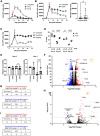HIV-1-induced type I IFNs promote viral latency in macrophages
- PMID: 35588262
- PMCID: PMC9613502
- DOI: 10.1002/JLB.4MA0422-616R
HIV-1-induced type I IFNs promote viral latency in macrophages
Abstract
Macrophages chronically infected with HIV-1 serve as a reservoir that contributes to HIV-1 persistence during antiretroviral therapy; however, the mechanisms governing the establishment and maintenance of this virus reservoir have not been fully elucidated. Here, we show that HIV-1 enters a state reminiscent of latency in monocyte-derived macrophages (MDMs), characterized by integrated proviral DNA with decreased viral transcription. This quiescent state is associated with decreased NF-κB p65, RNA polymerase II, and p-TEFb recruitment to the HIV-1 promoter as well as maintenance of promoter chromatin in a transcriptionally nonpermissive state. MDM transition to viral latency is mediated by type I IFN signaling, as inhibiting type I IFN signaling or blocking type 1 IFN prevents the establishment of latent infection. Knockdown studies demonstrate that the innate immune signaling molecule mitochondrial antiviral signaling protein (MAVS) is required for the transition to latency. Finally, we demonstrate a role for the viral accessory protein Vpr in the establishment of HIV-1 latency in macrophages. Our data indicate that HIV-1-induced type I IFN production is responsible for the establishment of viral latency in MDMs and identify possible therapeutic targets for the prevention or elimination of this important HIV-1 reservoir.
Keywords: HIV-1; IFN; MAVS; NF-κB; latency; macrophage.
© 2022 The Authors. Journal of Leukocyte Biology published by Wiley Periodicals LLC on behalf of Society for Leukocyte Biology.
Conflict of interest statement
The authors declare no conflict of interest
Figures






References
-
- Gallant J, Hsue PY, Shreay S, Meyer N. Comorbidities among US patients with prevalent HIV INFECTION‐A trend analysis. J Infect Dis. 2017;216:1525‐1533. - PubMed
-
- Finzi D, Hermankova M, Pierson T, et al. Identification of a reservoir for HIV‐1 in patients on highly active antiretroviral therapy. Science. 1997;278:1295‐300. - PubMed
-
- Chun TW, Carruth L, Finzi D, et al. Quantification of latent tissue reservoirs and total body viral load in HIV‐1 infection. Nature. 1997;387:183‐8. - PubMed
-
- Wong JK, Hezareh M, Gunthard HF, et al. Recovery of replication‐competent HIV despite prolonged suppression of plasma viremia. Science. 1997;278:1291‐5. - PubMed
Publication types
MeSH terms
Substances
Grants and funding
LinkOut - more resources
Full Text Sources
Medical
Miscellaneous

